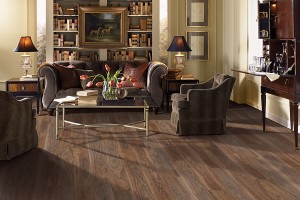Sustainable Flooring is derived from materials that reduce demands on our ecosystem during its life-cycle. This encompasses all aspects of production, from harvest, usage, as well as disposal of the product. Many believe that sustainable flooring promotes buildings that are much safer and better healthier for those residing in them. It is very popular with hypoallergenic homeowners. Currently, two popular types of sustainable flooring used in homes are bamboo and cork flooring.
About Bamboo Flooring for Your Home
You may have seen bamboo flooring before with out even noticing it. It has been commonly seen in gym floors and looks just like hardwood flooring. Bamboo is the currently the fastest growing plant in the world and it is a highly recognizable renewable resource in a multitude of industries. Bamboo can be typically harvested every three to six years for construction purposes while, traditional hardwoods can only be harvested every 25-50 years depending on the type of wood. It is extremely hard and stable and is known to be two and a half times harder than the common oak wood. Today, most of the bamboo supplied for flooring comes from China and some parts of Asia. Bamboo is very interesting, because is does not need to be replanted since the root system is left intact when it is harvested.
Within five years, a sustainbly harvest forest is harvested completely. Each year only 20% of the forest is harvested, allowing for regrowth.
Maintaining your bamboo floors is important. Just like hardwood flooring, bamboo should be swept or vacuumed regularly. When mopping, remove dust with a dust mop. Never use a wet mop on the floors even though bamboo is water-resistant, it can potentially harm any finishes on the flooring. When using a cleaner, make sure it will not leave any residue they will inhibit the floor bonding. The best type of long term maintenance is to apply a urethane finish to the bamboo floors.

The Benefits of Cork Flooring
Cork is another environmentally sound material that has numerous natural features that appeal to homeowners. Since cork is made using only the bark of a cork oak tree, the trees are not damaged during the harvesting and creation of the cork planks. Cork trees are very slow to grow and can live to upwards of 170-250 years. They can be harvested multiple times throughout the tree’s life and harvesting occurs every 9-12 years. Cork oak trees can be harvested up to 16 times in its life. The trees are harvested after when the sapling reaches 25 years of age or any time the trunk reaches a circumference of about 70cm.

Cork is a great flooring choice for several reasons: its softness, resiliency, natural ability to maintain a warm temperature, natural fire retardant, and it is a hypoallergenic. Cork has a honeycomb-like web of cells that retain air, which gives it the ability to float and re-expand after compression. This provides the softness under your foot. Along with its softness, cork possesses resilience which is great on one’s joints and gives the flooring the ability to bounce back when something of size and weight falls on the floor. Cork also naturally maintains a warm temperature. The air in the cork’s cells provides an insulation which acts as a thermal insulator. With this, homeowners with cork flooring can potentially reduce their heating and cooling costs. Cork is known as a natural fire retardant because it contains suberin, which is a waxy substance that is a natural fire inhibitor and will even repel termites. Lastly, because cork does not absorb dust or allergens it would be a great option for homeowners who have asthma or suffer from airborne allergies.
Maintaining cork flooring is easy and very low maintenance. It is recommended like any other wood flooring to vacuum and sweep regularly. Cork can be cleaned with a damp mop and a pH-balanced or very mild detergent. Using harsh cleaner will ruin the cork flooring and can potentially void the warranty.


Leave a Reply